Stable and Unstable Malaria Hotspots in Longitudinal Cohort Studies in Kenya
Background:
Infectious diseases often demonstrate heterogeneity of transmission among host populations. This heterogeneity reduces the efficacy of control strategies, but also implies that focusing control strategies on “hotspots” of transmission could be highly effective.
Methods and Findings:
In order to identify hotspots of malaria transmission, we analysed longitudinal data on febrile malaria episodes, asymptomatic parasitaemia, and antibody titres over 12 y from 256 homesteads in three study areas in Kilifi District on the Kenyan coast. We examined heterogeneity by homestead, and identified groups of homesteads that formed hotspots using a spatial scan statistic. Two types of statistically significant hotspots were detected; stable hotspots of asymptomatic parasitaemia and unstable hotspots of febrile malaria. The stable hotspots were associated with higher average AMA-1 antibody titres than the unstable clusters (optical density [OD] = 1.24, 95% confidence interval [CI] 1.02–1.47 versus OD = 1.1, 95% CI 0.88–1.33) and lower mean ages of febrile malaria episodes (5.8 y, 95% CI 5.6–6.0 versus 5.91 y, 95% CI 5.7–6.1). A falling gradient of febrile malaria incidence was identified in the penumbrae of both hotspots. Hotspots were associated with AMA-1 titres, but not seroconversion rates. In order to target control measures, homesteads at risk of febrile malaria could be predicted by identifying the 20% of homesteads that experienced an episode of febrile malaria during one month in the dry season. That 20% subsequently experienced 65% of all febrile malaria episodes during the following year. A definition based on remote sensing data was 81% sensitive and 63% specific for the stable hotspots of asymptomatic malaria.
Conclusions:
Hotspots of asymptomatic parasitaemia are stable over time, but hotspots of febrile malaria are unstable. This finding may be because immunity offsets the high rate of febrile malaria that might otherwise result in stable hotspots, whereas unstable hotspots necessarily affect a population with less prior exposure to malaria.
: Please see later in the article for the Editors' Summary
Published in the journal:
Stable and Unstable Malaria Hotspots in Longitudinal Cohort Studies in Kenya. PLoS Med 7(7): e32767. doi:10.1371/journal.pmed.1000304
Category:
Research Article
doi:
https://doi.org/10.1371/journal.pmed.1000304
Summary
Background:
Infectious diseases often demonstrate heterogeneity of transmission among host populations. This heterogeneity reduces the efficacy of control strategies, but also implies that focusing control strategies on “hotspots” of transmission could be highly effective.
Methods and Findings:
In order to identify hotspots of malaria transmission, we analysed longitudinal data on febrile malaria episodes, asymptomatic parasitaemia, and antibody titres over 12 y from 256 homesteads in three study areas in Kilifi District on the Kenyan coast. We examined heterogeneity by homestead, and identified groups of homesteads that formed hotspots using a spatial scan statistic. Two types of statistically significant hotspots were detected; stable hotspots of asymptomatic parasitaemia and unstable hotspots of febrile malaria. The stable hotspots were associated with higher average AMA-1 antibody titres than the unstable clusters (optical density [OD] = 1.24, 95% confidence interval [CI] 1.02–1.47 versus OD = 1.1, 95% CI 0.88–1.33) and lower mean ages of febrile malaria episodes (5.8 y, 95% CI 5.6–6.0 versus 5.91 y, 95% CI 5.7–6.1). A falling gradient of febrile malaria incidence was identified in the penumbrae of both hotspots. Hotspots were associated with AMA-1 titres, but not seroconversion rates. In order to target control measures, homesteads at risk of febrile malaria could be predicted by identifying the 20% of homesteads that experienced an episode of febrile malaria during one month in the dry season. That 20% subsequently experienced 65% of all febrile malaria episodes during the following year. A definition based on remote sensing data was 81% sensitive and 63% specific for the stable hotspots of asymptomatic malaria.
Conclusions:
Hotspots of asymptomatic parasitaemia are stable over time, but hotspots of febrile malaria are unstable. This finding may be because immunity offsets the high rate of febrile malaria that might otherwise result in stable hotspots, whereas unstable hotspots necessarily affect a population with less prior exposure to malaria.
: Please see later in the article for the Editors' Summary
Introduction
Many infectious disease show marked heterogeneity of transmission [1]. Mathematical models predict that this heterogeneity reduces the efficacy of disease control strategies [2], and intensifying control measures on foci of high transmission is predicted to be very effective in reducing overall transmission [1]. Marked spatial heterogeneity of malaria transmission on the household level is consistently detected when analysed [3]–[9], and results from both genetic and environmental factors [10],[11]. It is unclear how stable hotspots are in longitudinal data.
Malaria risk is related to environmental factors [12] including altitude [13], cultivation practices [14], urbanization [15], and distance from bodies of water [16]. However, ecological analyses to guide malaria control have been limited by the following factors: the overall models are complex [17]–[19], the same ecological feature may not have a consistent effect in different settings [20],[21], and there is marked residual variation in malaria risk despite models with detailed ecological data [22]. Furthermore, the resolution of multitemporal remote sensing satellite data (i.e. data based on more than a single snap-shot) for environmental monitoring is rarely finer than 0.5–1 km [23].
Since vector dispersion occurs on average over 0.5–1 km distances [24]–[29], this is the scale at which “hotspots” of transmission need to be identified in order to impact overall transmission. Malaria episodes have been found to cluster at this scale to form hotspots in high resolution geo-spatial analyses in Mali [6], Uganda [7], Ethiopia [30], and the highlands of Kenya [31],[32].
Here, we have conducted an analysis of malaria episodes and parasitaemia over 12 y, a substantially longer time period than has been reported previously, across three different cohorts without conspicuous variations in geography, such as nearby water bodies. We examine febrile episodes, asymptomatic parasitaemia, serological markers of exposure, environmental remote sensing data, and molecular studies of parasite clones to describe the spatial and temporal limits of hotspots, and to examine whether heterogeneity can be predicted.
Methods
The approval for human participation in these cohorts was given by Kenya Medical Research Institute Scientific committee and National Review and Ethical Committee of Kenya Medical Research Institute, and was conducted according to the principles of the declaration of Helsinki.
Surveillance for Malaria
The cohorts under surveillance for malaria episodes were located in Chonyi, Ngerenya, and Junju sublocations of Kilifi District, on the coast of Kenya between January 1998 and June 2009 (Figure 1). Concurrent entomological studies and parasite prevalence rates suggest that the transmission intensity is higher in Junju and Chonyi than in Ngerenya [33],[34], but transmission has been falling throughout the period of study [35].
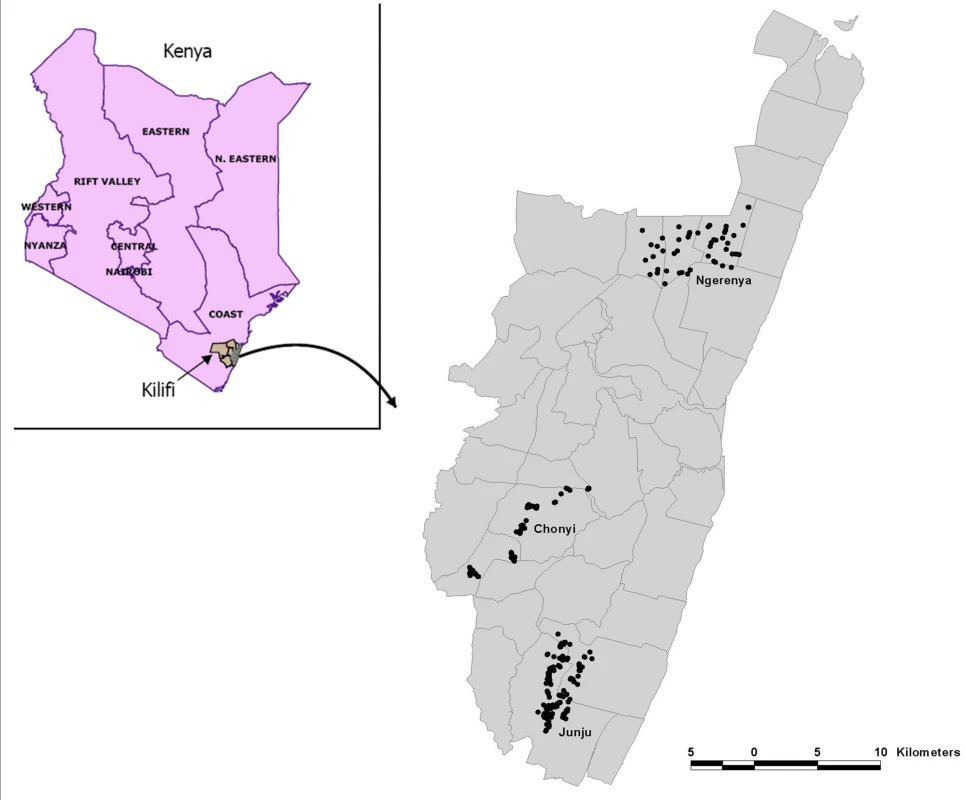
The field methods used to identify episodes of febrile malaria and asymptomatic parasitaemia have previously been described [36],[37]. Weekly active surveillance was undertaken, and children with fever had blood slides for malaria parasites. In Chonyi and Ngerenya, children with either subjective (i.e., reported) or objective fever (temperature ≥37.5°C) had blood smears performed for estimating the parasite density. In Junju blood smears were done only on children with an objective fever, but children with subjective fever were seen again 6–12 h later, and the temperature measurement repeated. Blood smears were made if objective fever was confirmed at this measurement.
The parents of the children in Chonyi and Ngerenya were instructed to report to Kilifi District Hospital 20 km away if the child had any symptoms of disease at any time (and reimbursed for travel expenses), and in Junju trained field workers were available at all times in the villages for passive surveillance. Antimalarials were supplied for proven episodes of malaria by the study team in accordance with government of Kenya guidelines; this was sulfadoxine-pyrimethamine until 2004, and co-artemether thereafter. Study participants may have used private clinics or bought antimalarials without the study team's knowledge, but given the availability of free treatment this was probably infrequent.
Surveys for asymptomatic parasitaemia were undertaken once yearly, immediately before the rainy season. All individuals recruited to the study were asked to attend for blood sampling, and microscopy results were available for 70%–88% of participants for each survey.
The Geographic Positioning System coordinates from the Kilifi Demographic Surveillance Survey were linked to each homestead in the study. In Ngerenya and Chonyi, all the residents at individual homesteads were recruited, but in Junju only children under 8 y of age were recruited. The homesteads in Ngerenya and Junju were evenly spaced throughout the study location, but in Chonyi the homesteads were distributed along a central road through the study area. Children born in the study homesteads during the period of monitoring were recruited, and so the average age of the cohort did not increase over time (Table 1).
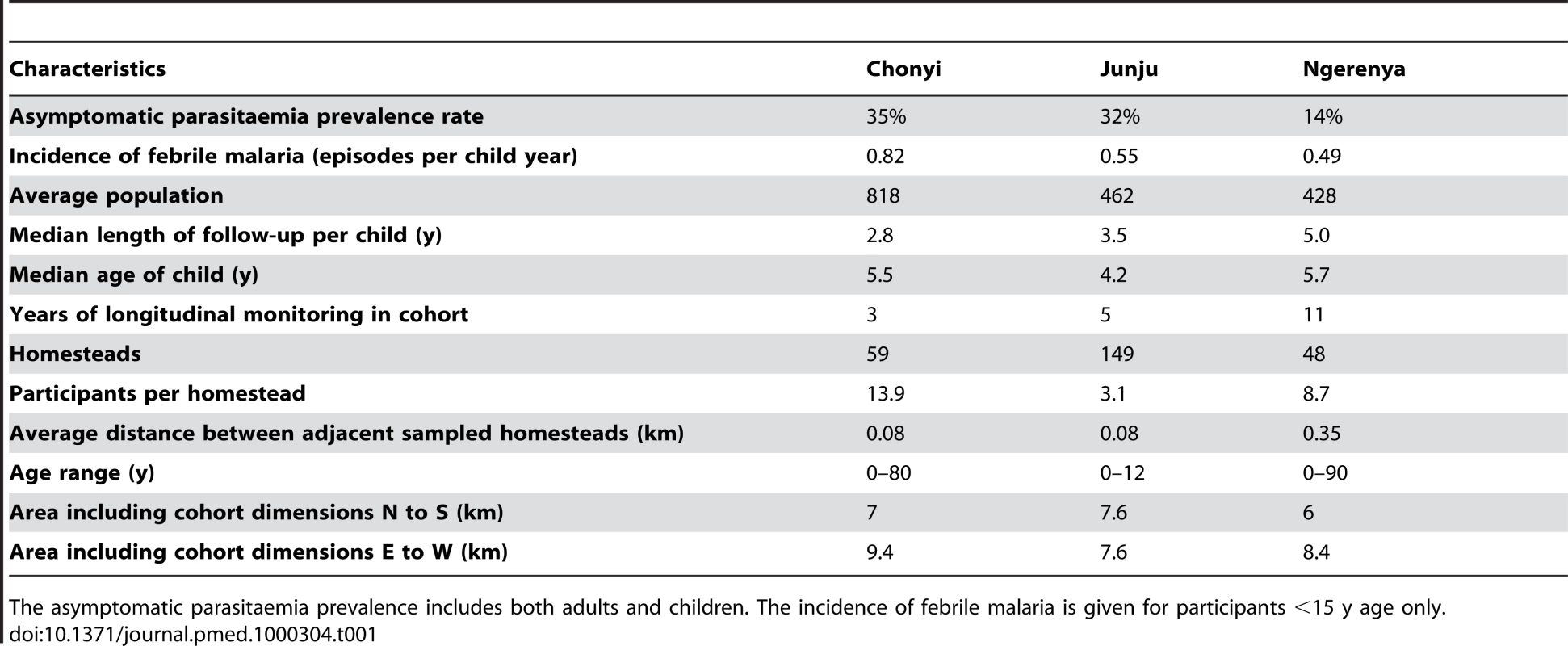
Definition of Febrile Malaria Incidence and Parasite Rates
Episodes of febrile malaria were determined using a parasite density threshold of >2,500/µl [36]. Episodes of febrile malaria were censored for 21 d after the last episode. The incidence per homestead per year was calculated by episodes of febrile malaria per homestead divided by the number of children who were <15 y old and by the number of years that participants were monitored. The parasite rate per homestead was calculated as the percentage of blood films positive for Plasmodium falciparum malaria from afebrile participants at scheduled blood sampling, including both adults and children.
Analysis of Hotspots
The SaTScan software [38] was used to calculate the spatial scan statistic [39]. The spatial scan statistic uses a scanning window that moves across space. For each location and size of the window, the number of observed and expected cases is counted, and the window with the greatest ratio of observed to expected cases is noted. The numbers of expected cases are calculated by considering an even distribution of cases across the population. The statistical significance of this cluster (or “hotspot”) is then evaluated taking into account the multiple tests for the many potential cluster locations and sizes evaluated [40]. The scan statistic was then calculated for two types of cluster; to identify clusters (or “hotspots”) of febrile disease, using a discrete Poisson model; and to identify clusters (or “hotspots”) of asymptomatic parasitaemia, using a Bernoulli model, where cases were participants with parasitaemia and controls were participants without parasitaemia.
A spatial-only model was repeated each year rather than a temporal-spatial model for the entire period of monitoring for three reasons. First, the frequent seasonal peaks in transmission could only be adjusted for after assuming their uniformity across the study area. Secondly, the size of the database (11 y and 256 homesteads) made secondary clusters (or “hotspots”) very likely, and the option of excluding primary clusters to analyse for secondary clusters is not available for temporal-spatial analyses, but is validated for spatial-only analyses [41]. Thirdly, we could then compare hotspots of febrile disease on the basis of each year of monitoring with hotspots of asymptomatic parasitaemia and antibody titres measured on annual cross-sectional surveys.
The rate ratio (RR) was defined as the ratio of observed to expected cases, as produced in the SaTScan output. The test of significance was based on a Poisson generalized likelihood ratio test, using 9999 replications for a Monte Carlo inference. In order to run scans, the maximum cluster/hotspot size was set at 30% of the population, and the inference level for significance was set at 0.05 for primary clusters/hotspots (i.e., the window found with the highest RR). After removing the primary cluster/hotspot, the scan statistic was recalculated for the remaining locations in order to identify secondary clusters/hotspots. This calculation was only done where strongly significant (p<0.001) primary clusters/hotspots were identified.
A modified Poisson regression [42] was used to examine the relationships between clustering in different years, which were determined by scoring each homestead 0 or 1 for its absence or presence in any cluster under each condition.
MSP-2 Genotyping of P. falciparum Infection
Amplification of the merozoite surface protein 2 (MSP-2) domain following capillary electrophoresis was used to accurately measure fragment size [43]. In the primary PCR reaction, the entire polymorphic region of MSP-2 (block 3) was amplified, and in the following nested reactions the allelic types FC27 and IC were amplified separately. In the capillary electrophoresis-based method fluorescently labelled oligonucleotide primers were used in the nested reaction, and fragment analysis was performed in a 96-well format on a 3130xl DNA sequencer and GeneMapper Software version 4.0 (both Applied Biosystems). A 150 relative fluorescent unit (rfu) cut-off was used. Discrete clones were described by the allelic type and PCR product fragment size, aggregated over three base pair intervals (i.e., considered within the error of the method rather than the genetic structure of the alleles). Clones that were present in less than 3% of samples were described as “other.”
Antibody Studies
Antibody titres against recombinant antigens of P. falciparum (3D7) were measured in a standard ELISA as reported in previous studies in Chonyi [44]–[46] and in Ngerenya [45],[46]. Antibody titres were not available from Junju. The recombinant antigen AMA-1 was provided by Sheetij Dutta and David Lanar [47], and recombinant MSP-2 was provided by Dave Conway and Spencer Polley using a plasmid provided by Jana McBride and David Cavanagh [46]. The optical density (OD) reading was used as a proxy for antibody concentration, and seropositivity was determined by an OD reading above the mean response plus three standard deviations for nonexposed control sera.
Remote Sensing
MODIS is a sensor on board two NASA satellites. MODIS-derived temperature and reflectance layers were acquired for the years 2001 through 2008 [48]. A set of four channels; middle infra-red reflectance, daytime land surface temperature, night-time land surface temperature, and the enhanced vegetation index (EVI) were then processed by a temporal Fourier algorithm to achieve temporal ordination of the data time series while preserving important aspects of seasonal variation in the measures [49]. Each channel was then described by the following parameters: mean, minimum and maximum, and the amplitude, phase and variance of annual and bi-annual cycles decomposed from the data. A multivariable logistic regression model to predict hotspots using these parameters was developed from the best fit parameter in each channel, with subsequent exclusion of nonsignificant parameters (p>0.05). The most significant parameters from each channel were then combined in a final multivariable logistic regression model, with further exclusion of nonsignificant parameters (p>0.05). There are approximately 120 MODIS picture elements (pixels) widths/heights to each degree of latitude/longitude at the equator (i.e., approximately 1 km squared per pixel), so several homesteads are included in each pixel. The logistic regression models were therefore adjusted to take account of the nonindependence of observations by using the sandwich estimator to group observations by pixel [50]. The coefficients and constant from the final model (i.e., with p<0.05) were then used with the observed remote sensing data, to derive a predicted probability of a hotspot, which was then used to derive sensitivity and specificities for hotspot prediction.
Results
Data were analysed from 256 homesteads in three study cohorts, where 5,600 episodes of febrile malaria were recorded over 32,452 person years of observation. The average incidence of malaria was 0.49 per child per year (cpy) in the lowest incidence cohort, and 0.82 per cpy in the highest incidence cohort (Table 1). Behind these summary statistics was substantial heterogeneity, with individual homestead incidences of febrile malaria ranging from zero to two episodes per cpy over the 3–11 y of monitoring (Figures S1 and S2).
Spatial Limits of Clusters of Malaria
Episodes of febrile malaria were aggregated in “hotspots” or clusters (Table 2). The geometric mean of the RR for the clusters was 2.35 (range 1.3–28). 14% of the population monitored were within a hotspot at any one time. A total of 23 of the 26 hotspots were significant (i.e., p<0.05) and retained for further analysis. 17 of the 26 were strongly significant (i.e., p<0.005).

The average hotspot had a 1.3-km radius. There were six hotspots, where the apparent radius was less than the closest distance between sampled homesteads (i.e., the hotspot was a single homestead). All these hotspots were in Ngerenya, where there was the greatest distance between sampled homesteads (Table 1).
Asymptomatic parasitaemia was also aggregated into hotspots, with a geometric mean RR of 2.9 (range 1.5–15). 14% of the population monitored were within a hotspot. 19 of the 35 potential hotspots identified were significant (p<0.05) and retained for further analysis. Six were strongly significant (p<0.005). The average radius of these hotspots was 1 km.
Gradient of Incidence on Moving from the Centre of a Hotspot to Outside the Hotspot
Based on the LOWESS curve, the incidence of febrile malaria was highest in the centre of a hotspot of febrile malaria (Figure 2), at 1.32 episodes/child year, and decreased towards the perimeter of the hotspot, where the mean incidence was 0.83 episodes/child year. The incidence of febrile malaria continued to fall gradually with distance outside the hotspot until reaching a plateau at 0.3 episodes/child year 3.7 km away from the perimeter of the hotspot. Between the centre to 3.7 km outside the perimeter, the gradient was −0.17 episodes/child year per km (95% confidence interval [CI] −0.2 to −0.14, p = 4×10−21). After 3.7 km, the gradient was −0.05 episodes/child year per km (95% CI −0.04 to 0.04, p = 0.8).
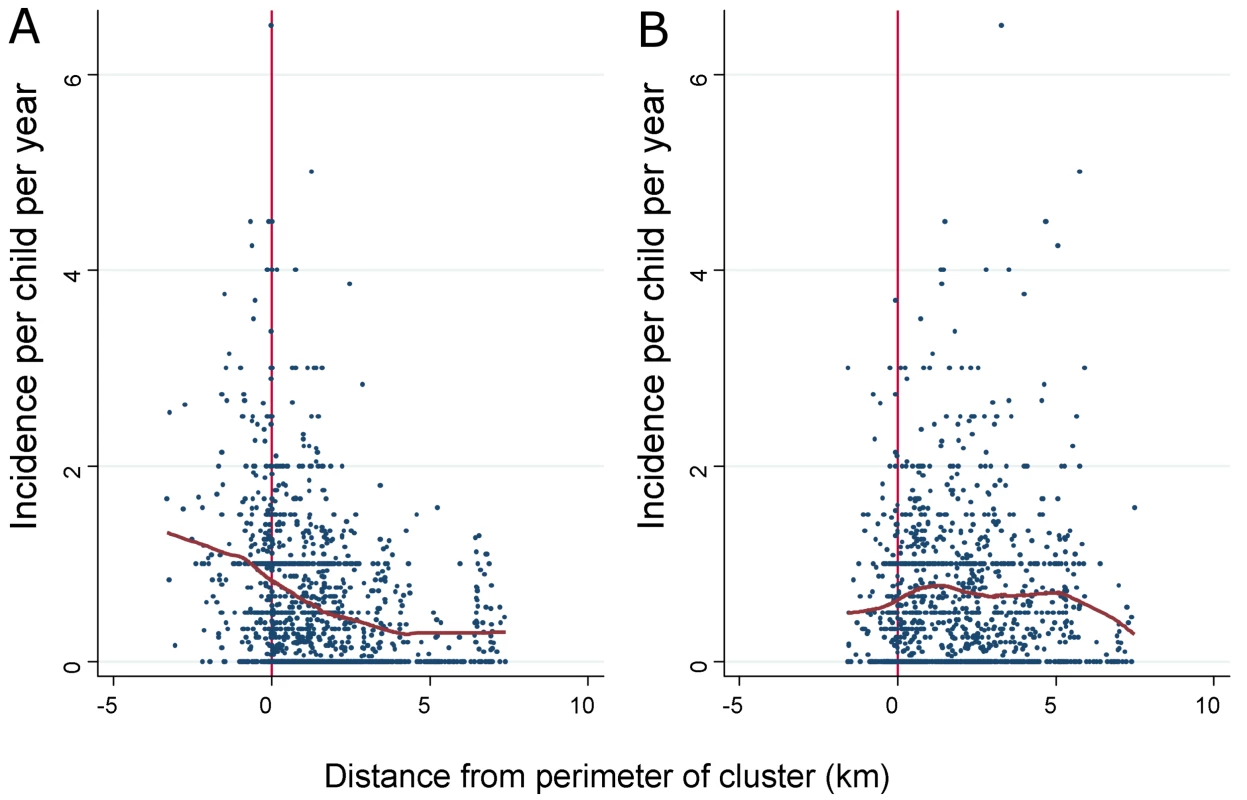
The highest point prevalence of asymptomatic parasitaemia was in the centre of a hotspot of asymptomatic parasitaemia, with a gradient of falling prevalence towards and then outside the perimeter of the hotspot. However, the incidence of febrile malaria was low in the centre of a hotspot of asymptomatic parasitaemia, at 0.49 episodes/child year by the LOWESS curve, and rose to 0.63 episodes/child year at the perimeter. Overall, the mean incidence within the hotspot was 0.6 episodes/child year, 95% CI 0.49–0.71. The peak incidence of 0.78 episodes/child year by LOWESS was reached 1.4 km away from the perimeter, and incidence then declined to 0.4 episodes/child year 7 km away from the perimeter. The mean incidence was 0.72 episodes/child year (95% CI 0.66–0.78) between 0 and 3 km from the perimeter of the hotspot of asymptomatic parasitaemia, and 0.48 episodes/child year (95% CI 0.41–0.55) after 3 km. The gradient of the incidence of febrile malaria was −0.033 episodes/child year per km outside the perimeter (95% CI −0.06 to −0.006, p = 0.016).
There was no consistent distance between contemporaneous hotspots of febrile malaria and hotspots of asymptomatic parasitaemia (range from 0 to 4.6 km).
Malariometrics of Hotspots of Febrile Malaria Versus Hotspots of Asymptomatic Parasitaemia
Children within hotspots of asymptomatic parasitaemia had higher antibody titres on cross-sectional samples, and a lower mean age at the time of febrile malaria than children in hotspots of febrile malaria (Table 3). As a consequence of their respective definitions, the parasite rates were higher in hotspots of asymptomatic parasitaemia and the incidence of febrile malaria higher in hotspots of febrile malaria.

Temporal Stability of Hotspots
The position of hotspoting of febrile malaria changed from year to year in two study areas, although there was a subset of houses that remained within hotspots from year to year (Figure 3). Overall, the distribution of homesteads in a hotspot was moderately predictive of the distribution of hotspots for the following year, but became less predictive of the hotspots present after 4 y or longer. In contrast, hotspots of asymptomatic parasitaemia were more stable over time (Figure 4). The distribution of homesteads was more strongly predictive of hotspots the next year, and was still predictive of hotspots 7 y later (Table 4).
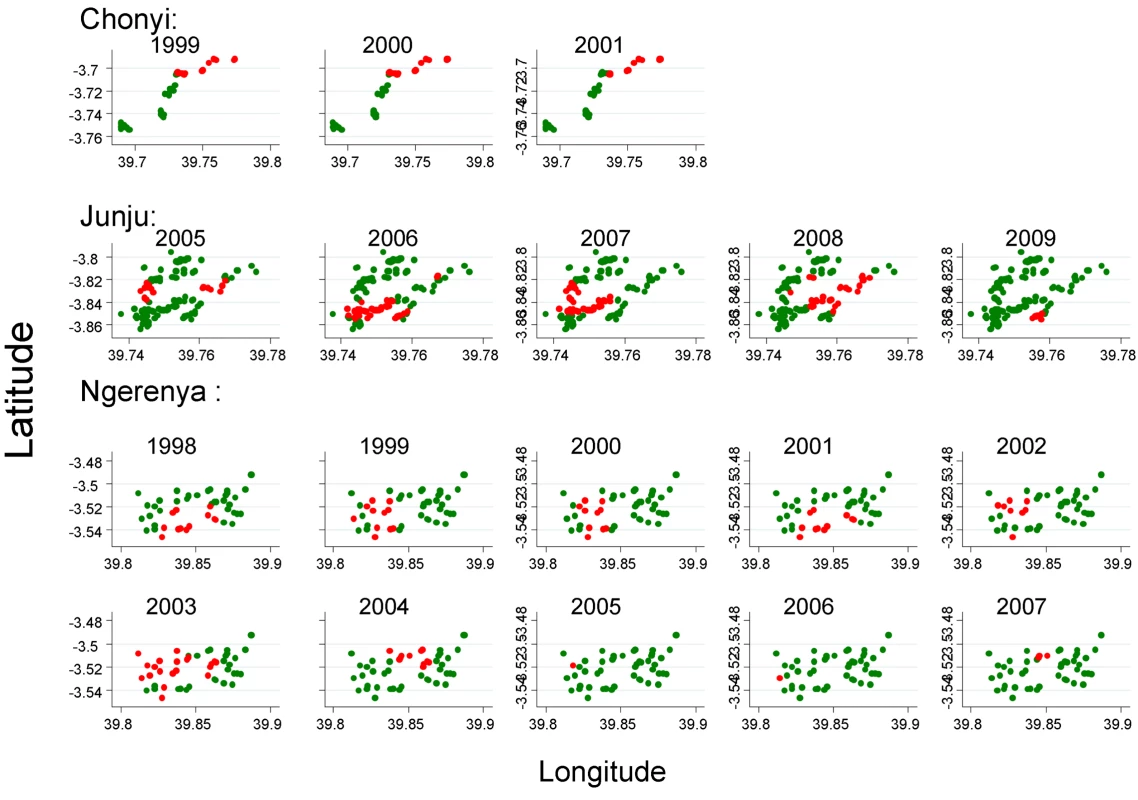
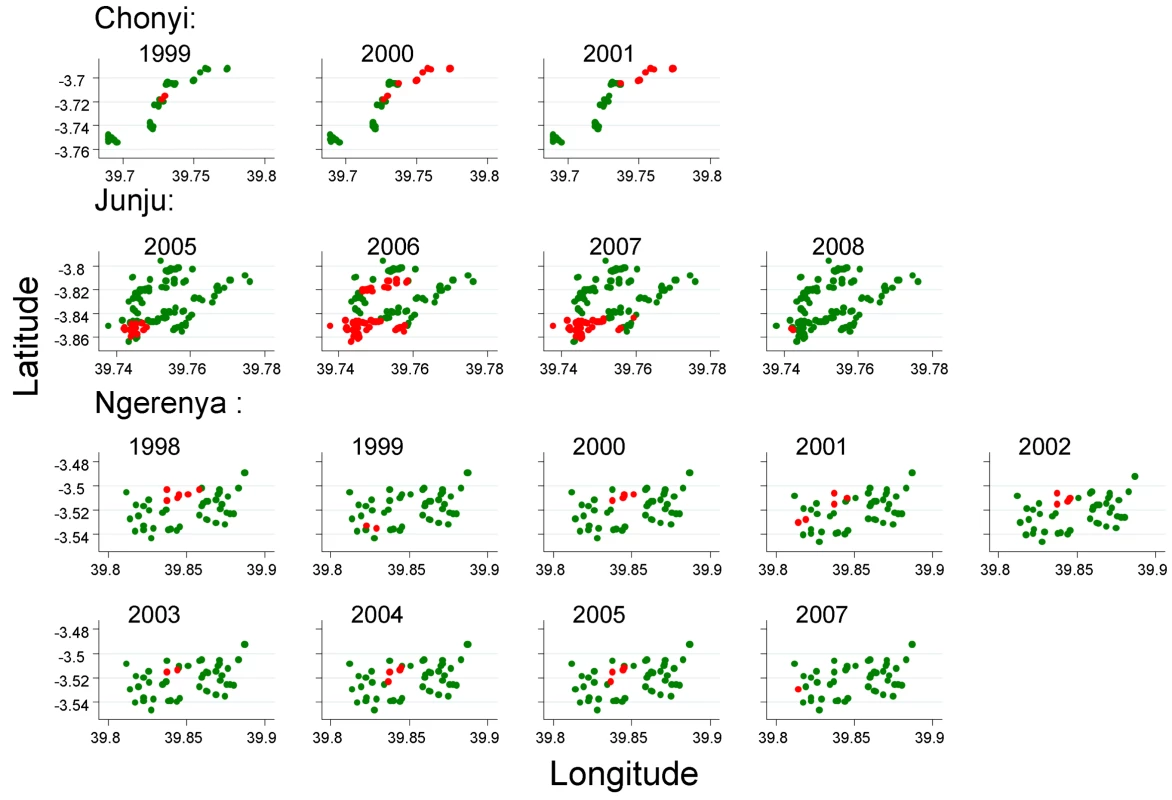
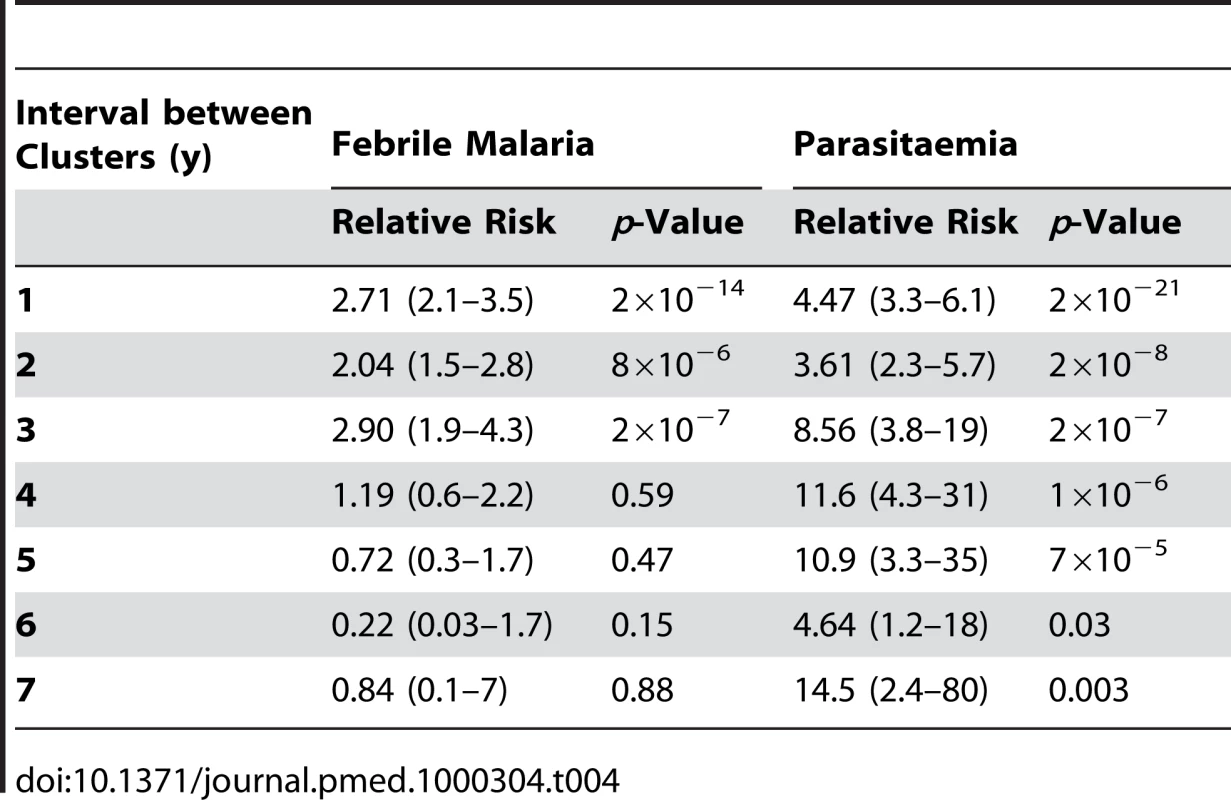
Although the location of hotspots of febrile malaria varied by year, they did not vary on a pooled analysis by season (Figure 5). The distribution of hotspots during the short rains predicted hotspots during the long rains (RR = 3.91, 95% CI 2.7–5.2, p = 7×10−10) and dry season (RR = 5.23, 95% CI 4.0–6.5, p = 3×10−16), and the hotspots seen in the dry season predicted hotspots during the long rains (RR = 4.45, 95% CI 3.0–5.9, p = 3.7×10−9).
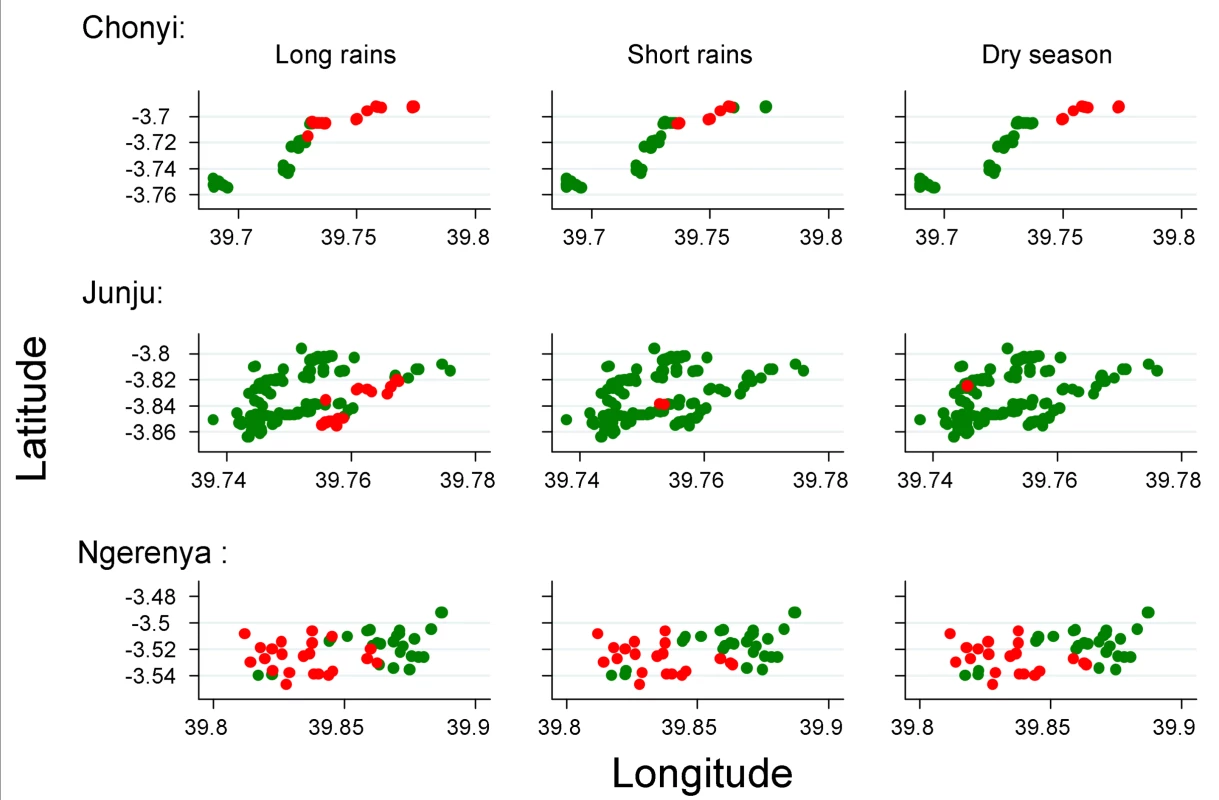
Homestead Level Clustering Versus Hotspots of Homesteads
There appeared to be substantial variation in the incidence of malaria outside the hotspots (Figures S2 and S3). Variation in risk at the homestead level was stable from year to year, even when analysing the homesteads inside and outside hotspots separately (Table 5). The geographical heterogeneity in asymptomatic parasitaemia at the homestead level was more stable over time than the heterogeneity for febrile malaria.
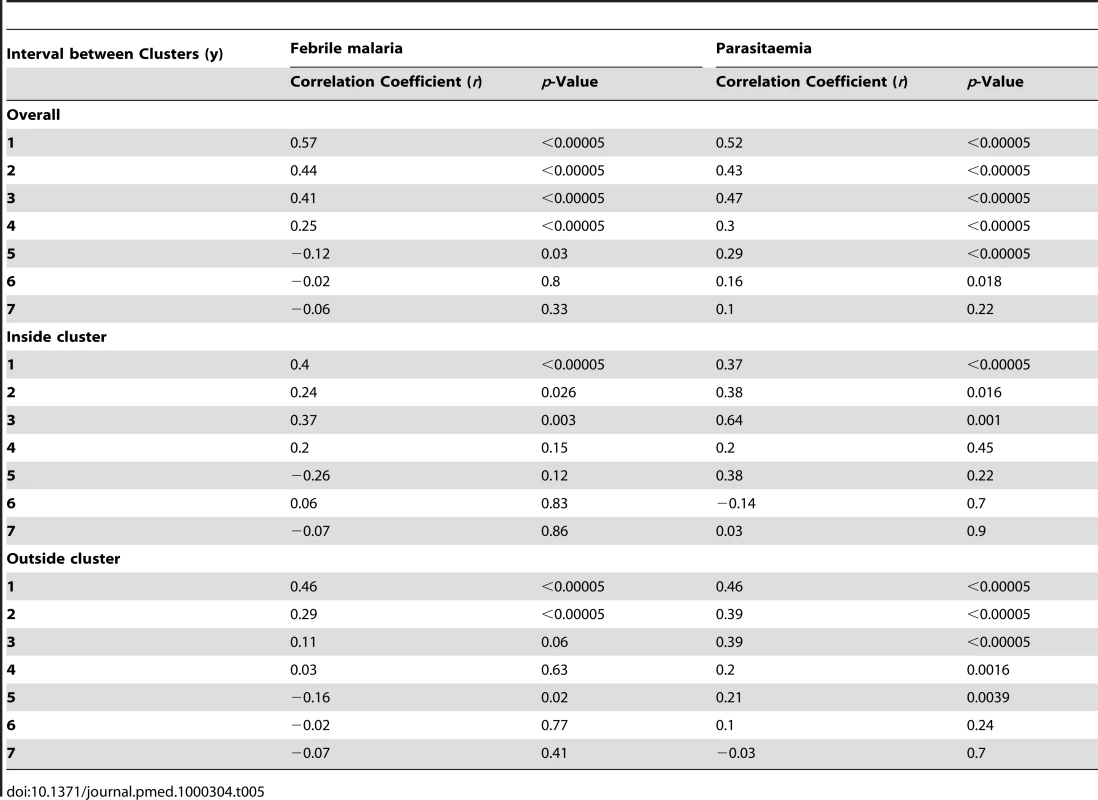
Prediction of Hotspots by Serology
The antibody response to MSP-2 was used to determine hotspots in three ways; by the OD measurement (as a continuous variable), by the seropositivity rate, and by the seroconversion rate using a catalytic model. Neither the seropositivity rate nor seroconversion rate were associated with hotspots of febrile malaria or parasitaemia (OR = 0.99, 95% CI 0.98–1.01 p = 0.4 and OR = 1.03, 95% CI 0.95–1.1, p = 0.5). However, the OD measurements predicted concurrent hotspots of febrile malaria and parasitaemia significantly (OR = 3.77, 95% CI 1.3–10, p = 0.012 and OR = 5.9, 95% CI 1.7–20, p = 0.005, respectively), giving a sensitivity and specificity of 68% and 73% for febrile malaria hotspots, and 65% and 69% for asymptomatic parasitaemia hotspots, respectively. The OD remained associated with asymptomatic parasitaemia hotspots 3 y after the original measurement (OR = 20.1, 95% CI 1.2–300, p = 0.037), and with febrile malaria hotspots 2 y later (OR = 4.1, 95% CI 1.5–11, p = 0.005) but not at 3 y (OR = 2.5, 95% CI 0.3–18, p = 0.4).
AMA-1 responses were associated with hotspots of asymptomatic parasitaemia (OR = 3.5, 95% CI 1.3–10, p = 0.016) but not hotspots of febrile malaria (OR = 1.5, 95% CI 0.7–3.5, p = 0.3) (See Figure S1 for receiver operating characteristic [ROC] curves for antibody titres).
Prediction of Hotspots by Remote Sensing Data
Environmental factors indicated by remote sensing data were strongly implicated in determining hotspots of asymptomatic parasitaemia, either by selection of dominant parameters or from principal component analysis (Table 6). The first three components of the principal component analysis had Eigenvalues of 7.09, 5.97, and 4.43, accounting for 49% of the total variance. The remaining components had Eigenvalues <3, and each accounted for 8% or less of the total variance. Definitions based on the logistic regression models from the MODIS satellite data were 65% sensitive and 67% specific from principal component analysis or 81% sensitive and 63% specific based on the model of selected independent predictors.
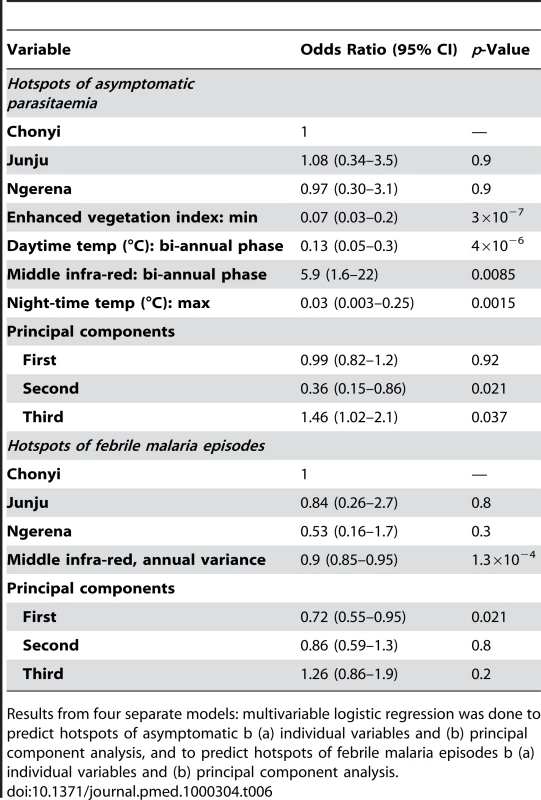
Hotspots of febrile malaria were less strongly linked to the remote sensing data, and the significant factors differed from those that identified hotspots of asymptomatic parasitaemia. Definitions for febrile malaria hotspots were only 62% sensitive and 30% specific from principal components or 81% sensitive and 50% specific from the selected independent predictor (see Figure S3).
Parasite Genotyping Data by Hotspot
In Junju parasite genotypes according to MSP-2 fragment size by capillary tube electrophoresis were available. There were 26 common alleles (i.e., represented in more than ten individuals) and 66 less common alleles that were classified as “other”. An overall analysis of variance showed significant variation in the distribution of clones (p = 0.016). Post hoc testing (Table 7) suggested that this variation was due to three genotypes that were overrepresented inside the hotspot: fc419 (16% versus 8%, p = 0.004); ic496 (5% versus 2%, p = 0.015); and ic545 (4% versus 1%, p = 0.017).
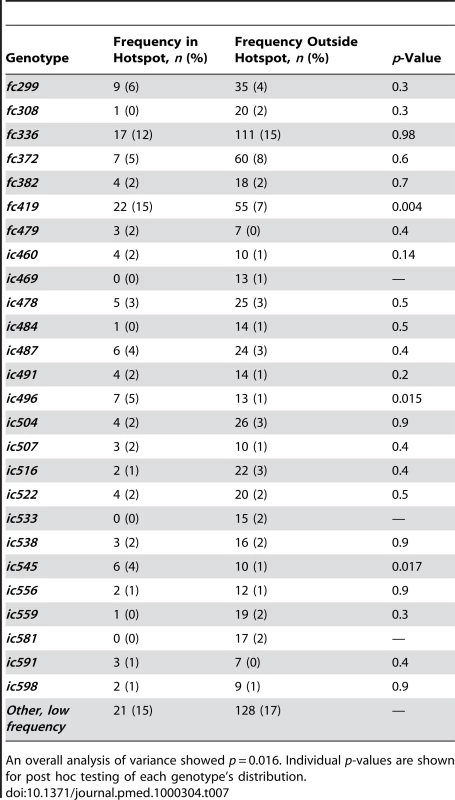
Predicted Operational Performance of Predictors of Heterogeneity
Using antibody titres, 20% of homesteads would be identified for an intervention with a cut-off of mean titre >1.0 OD, but only 37% of the whole cohort's malaria episodes would occur in these homesteads. In order to include 50% of the malaria episodes, a cut-off of 0.85 would be required, and this would require 32% of the homesteads in the study area to be treated.
Table 8 shows the results of monitoring episodes of febrile malaria during 1 or 2 mo of surveillance to predict febrile malaria episodes during the following year, on the basis of the assumption that any homestead with at least one episode of febrile malaria during the monitoring period would be targeted for treatment.
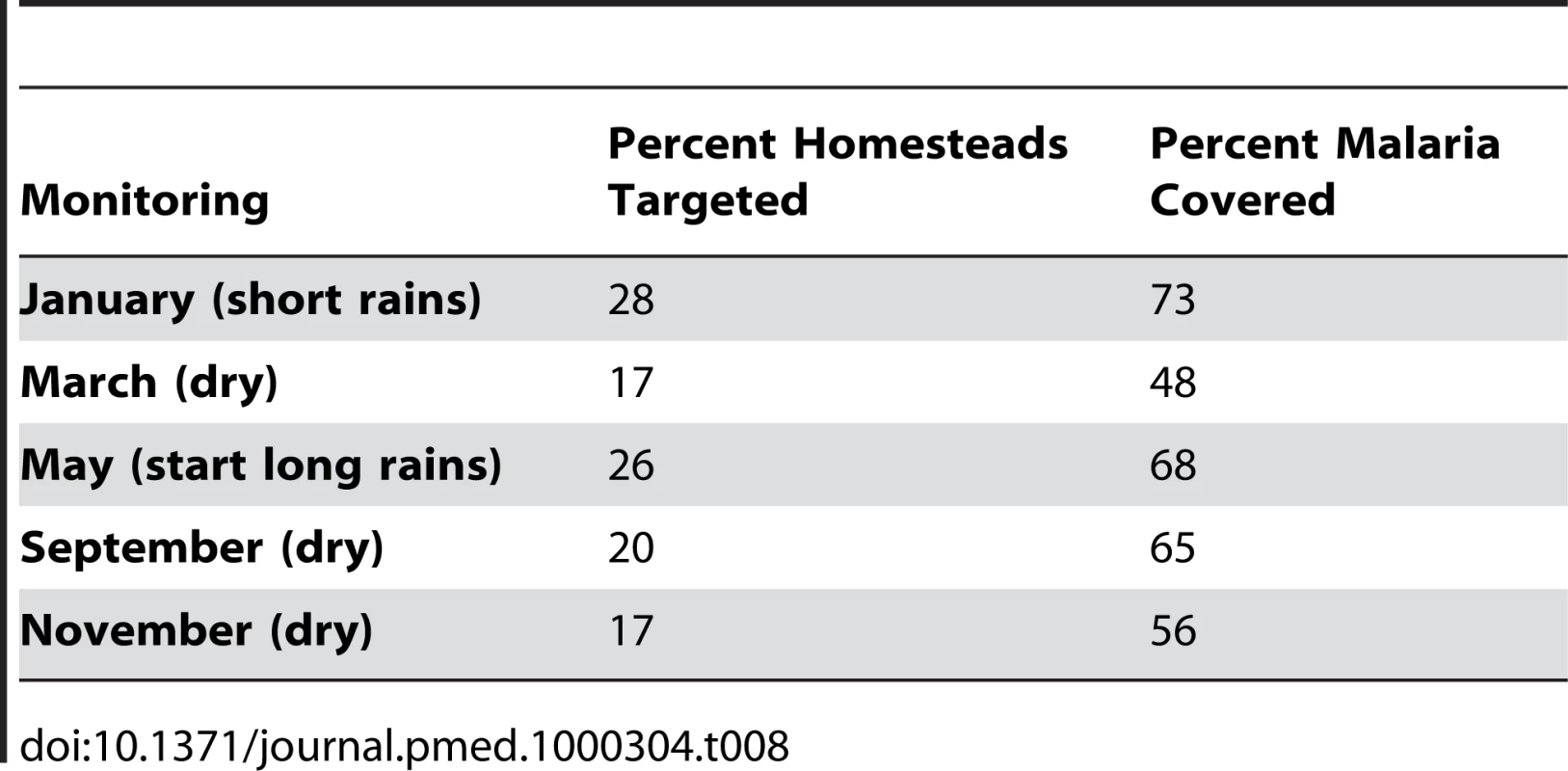
Discussion
We identified stable hotspots of asymptomatic parasitaemia, and unstable hotspots of febrile disease in each of three cohorts in Kilifi District. The hotspots of asymptomatic parasitaemia were characterized by nonsignificantly higher mean antibody titres, a lower mean age at febrile episodes, and lower overall incidences of febrile disease. There may have been an increase in the incidence of febrile malaria in the penumbra around the perimeter of the hotspots of asymptomatic parasitaemia (Figure 5). Furthermore, hotspots of asymptomatic parasitaemia were stable over the full 7 y of monitoring, whereas hotspots of febrile malaria were not stable past 3 y of monitoring. Taken together, these observations suggest the following explanation: that a rapid acquisition of immunity in stable high transmission hotspots offsets the high rates of febrile malaria that would otherwise result. Instead, a high prevalence of asymptomatic parasitaemia is seen [51]. Unstable hotspots are not associated with prior exposure, and hence relatively low levels of immunity, and therefore produce higher incidences of febrile disease. Although the unstable hotspots are directly associated with more febrile disease, hotspots of asymptomatic parasitaemia may be critical in maintaining transmission [52].
The satellite remote sensing data suggest a primarily environmental cause for stable hotspots, but it was unclear why some hotspots are unstable. It was not simply a seasonal effect, since there was no indication of a seasonal specificity of hotspots in pooled analysis by season. Potential explanations might be a changing prevailing wind direction [53] or the temporary presence of “superspreaders” as seen in other infectious diseases [54]. Insecticide-treated net (ITN) use has expanded in Kilifi generally [35] and in the Junju cohort specifically [55], but there was no evidence that there were hotspots of ITN use in our dataset (p = 0.9).
The study is based on active case detection in a sample of the total population (5%–10%). Data from the missing homesteads might alter the dimensions and frequency of the hotspots identified, and clarify whether clustering is stronger at the level of individual homestead or at the level of groups of homesteads that form “hotspots.” The resolution of remote sensing data results in an average of six homesteads per pixel. The remote sensing data predicted hotspots, but heterogeneity in risk by individual homestead was also observed, and higher resolution remote sensing data are needed to further investigate this.
The instability of hotspots of febrile malaria was not simply due to variations in age of the children monitored (Table 3). Furthermore, stable hotspots of asymptomatic parasitaemia were observed in Junju, where only children and not adults were recruited to the cohort. Although the three cohorts monitored were from geographically different areas, the study is limited by presenting data from a single district, and so cannot represent the great diversity of ecology that will be seen across sub-Saharan Africa. Other cohorts undergoing longitudinal surveillance should be examined to confirm our findings.
Malaria transmission varies by geographical features such as altitude [13], cultivation practices [14], streams and dams [16], house construction [56], socioeconomic factors [57], and ITN use [58]. Data on these factors were not available for the analysis presented here, although there were no large water bodies in the study area. However, a previous analysis in one of the study areas demonstrated that both environmental factors at the homestead level and host genetic factors contributed substantially to variation in malaria risk [10].
Our analysis suggests that environmental factors identified by remote sensing are associated with stable hotspots of asymptomatic parasitaemia. The environment in Kenya is seasonal, with two rainy seasons per year. The strongest individual factors from remote sensing were not the means of any index, but rather the minimum, and phases for a vegetation index and indicators of temperature, consistent with previous studies that have demonstrated the importance of temporal monitoring [12]. The remote sensing data show strong cross-correlation, and significant individual factors are likely to be proxies for more complex environmental determinants of transmission. 48 different measures of remote sensing were tested, but after a Bonferroni correction p = 1.4×10−5 and p = 2×10−4 for the two most significant individual factors.
The evidence for environmental causation of the unstable hotspots of febrile malaria was less strong. Nevertheless, p = 0.006 after a Bonferroni correction for the single individual factor retained in the final model.
On principle component analysis the second and third components were significantly associated with hotspots of asymptomatic parasitaemia, but the first component was associated with hotspots of febrile malaria. This finding is consistent with a complex environmental causation of hotspots rather than a single factor, and different environmental causes for the two types of hotspot.
Anti-AMA antibody titres were associated with hotspots, but seroprevalence and seroconversion rates did not predict hotspots. This association contrasts with previous findings on a larger geographical scale [59]. The effects of individual variation may become more noticeable on a smaller scale [60], and smaller scale hotspots are unlikely to be as stable as environmental features such as altitude that operate on a larger scale [61].
There was substantial heterogeneity of transmission inside and outside hotspots. This heterogeneity was not simply random variation, since the previous year's incidence per homestead was strongly predictive of subsequent risk (r = 0.57). Variation in malaria risk at the homestead level has been shown to be due to a mixture of genetic and environmental factors [10],[11]. Irrespective of the cause, hotspots have a substantial effect on overall transmission in the community [2]. Here, we demonstrate two levels of clustering; clustering at the homestead level, and hotspots of groups of high risk homesteads in 1.3-km radius areas. The “gradient” effect away from the perimeter of a hotspot is consistent with transmission in the majority of the cohort being maintained by transmission from within the hotspot of homesteads. Hence, targeting the 73% of febrile malaria within the 28% highest risk homesteads is likely to benefit the wider community, since the highest risk homesteads will increase transmission in the surrounding area [1].
The genotyping data suggest that individual parasite clones are associated with a hotspot of asymptomatic parasitaemia. This finding may be because particular hosts more frequently transmit their parasites within a hotspot [54], or because particular parasite clones have adapted to a geographical micro-environment, determined, for instance, by the vector species [62]. Genotypes were not available from febrile disease episodes.
Clustering of episodes by individual is reported in many infectious diseases [1], and has been relevant to the control of diverse pathogens such as Escherichia coli [54], tuberculosis [63], gonorrhea [64], SARS [65], and leishmaniasis [66]. Clustering of malaria episodes by homestead [10] and larger geographical hotspots including groups of homesteads is well described [3]–[9],[67], but there are few data on the temporal stability of hotspots.
Targeted strategies for malaria control need to consider two kinds of hotspot; stable hotspots of asymptomatic parasitaemia and unstable hotspots of febrile disease. One might argue against intervening in hotspots of asymptomatic parasitaemia, since rates of febrile disease are not high, and intervention might reduce host immunity. However, where transmission has fallen in areas of high transmission, substantial direct and indirect mortality and public health gains have been described in the short and long term [35],[68],[69]. Furthermore, these stable hotspots probably feed transmission in their penumbrae for a distance of several kilometres because of vector dispersion [24]–[29]. Hotspots of asymptomatic parasitaemia can be identified by parasite surveys, serological surveys, or, more conveniently, remote sensing.
Hotspots of febrile disease may be targeted by monitoring presentations to the local dispensary during the dry season, and targeting the effected homesteads during the subsequent rains. The optimal protocol would be to monitor during the dry season in September and then treat for the following year, which would result in targeting 20% of the homesteads, accounting for 65% of the febrile malaria episodes during the following year. It is optimal to cover 100% of the homesteads with any control intervention (particularly ITN distribution). However, some other interventions are currently not practical on community-wide scale, such as repeated mass drug administration [70],[71], environmental modification [72]–[74], mass vaccination [75], or (in some circumstances) indoor residual spraying (IRS) [76]–[78], but become feasible if targeted on the 20% of homesteads at greatest risk.
When transmission has reduced to very low levels, transmission remains geographically clustered [9],[79], and intensified control in these hotspots is key to achieving elimination. In our setting, as in much of sub-Saharan Africa, there is not an immediate prospect of elimination. Additional targeted control measures may be viewed simply as a cost-effective way of ensuring that those most in need get the intervention, but the stronger justification is that reducing transmission in hotspots will reduce transmission on the wider community [1].
Environmental interactions are complex in determining malaria risk per se [12], and so these findings should be validated in other datasets before firm recommendations for malaria control programmes are made.
Supporting Information
Zdroje
1. WoolhouseME
DyeC
EtardJF
SmithT
CharlwoodJD
1997 Heterogeneities in the transmission of infectious agents: implications for the design of control programs. Proc Natl Acad Sci U S A 94 338 342
2. SmithDL
McKenzieFE
SnowRW
HaySI
2007 Revisiting the basic reproductive number for malaria and its implications for malaria control. PLoS Biol 5 e42 doi:10.1371/journal.pbio.0050042
3. MackinnonMJ
GunawardenaDM
RajakarunaJ
WeerasinghaS
MendisKN
2000 Quantifying genetic and nongenetic contributions to malarial infection in a Sri Lankan population. Proc Natl Acad Sci U S A 97 12661 12666
4. Gamage-MendisAC
CarterR
MendisC
De ZoysaAP
HerathPR
1991 Clustering of malaria infections within an endemic population: risk of malaria associated with the type of housing construction. Am J Trop Med Hyg 45 77 85
5. GhebreyesusTA
HaileM
WittenKH
GetachewA
YohannesM
2000 Household risk factors for malaria among children in the Ethiopian highlands. Trans R Soc Trop Med Hyg 94 17 21
6. GaudartJ
PoudiougouB
DickoA
RanqueS
ToureO
2006 Space-time clustering of childhood malaria at the household level: a dynamic cohort in a Mali village. BMC Public Health 6 286
7. KreuelsB
KobbeR
AdjeiS
KreuzbergC
von RedenC
2008 Spatial variation of malaria incidence in young children from a geographically homogeneous area with high endemicity. J Infect Dis 197 85 93
8. SmithDL
DushoffJ
SnowRW
HaySI
2005 The entomological inoculation rate and Plasmodium falciparum infection in African children. Nature 438 492 495
9. BelizarioVY
SaulA
BustosMD
LansangMA
PasayCJ
1997 Field epidemiological studies on malaria in a low endemic area in the Philippines. Acta Trop 63 241 256
10. MackinnonMJ
MwangiTW
SnowRW
MarshK
WilliamsTN
2005 Heritability of malaria in Africa. PLoS Med 2 e340 doi:10.1371/journal.pmed.0020340
11. MwangiTW
FeganG
WilliamsTN
KinyanjuiSM
SnowRW
2008 Evidence for over-dispersion in the distribution of clinical malaria episodes in children. PLoS ONE 3 e2196 doi:10.1371/journal.pone.0002196
12. RogersDJ
RandolphSE
SnowRW
HaySI
2002 Satellite imagery in the study and forecast of malaria. Nature 415 710 715
13. ReyburnH
MbatiaR
DrakeleyC
BruceJ
CarneiroI
2005 Association of transmission intensity and age with clinical manifestations and case fatality of severe Plasmodium falciparum malaria. JAMA 293 1461 1470
14. LindsaySW
WilkinsHA
ZielerHA
DalyRJ
PetrarcaV
1991 Ability of Anopheles gambiae mosquitoes to transmit malaria during the dry and wet seasons in an area of irrigated rice cultivation in The Gambia. J Trop Med Hyg 94 313 324
15. HaySI
GuerraCA
TatemAJ
AtkinsonPM
SnowRW
2005 Urbanization, malaria transmission and disease burden in Africa. Nat Rev Microbiol 3 81 90
16. GhebreyesusTA
HaileM
WittenKH
GetachewA
YohannesAM
1999 Incidence of malaria among children living near dams in northern Ethiopia: community based incidence survey. BMJ 319 663 666
17. OmumboJA
HaySI
SnowRW
TatemAJ
RogersDJ
2005 Modelling malaria risk in East Africa at high-spatial resolution. Trop Med Int Health 10 557 566
18. CraigMH
SharpBL
MabasoML
KleinschmidtI
2007 Developing a spatial-statistical model and map of historical malaria prevalence in Botswana using a staged variable selection procedure. Int J Health Geogr 6 44
19. SnowRW
GouwsE
OmumboJ
RapuodaB
CraigMH
1998 Models to predict the intensity of Plasmodium falciparum transmission: applications to the burden of disease in Kenya. Trans R Soc Trop Med Hyg 92 601 606
20. GemperliA
SogobaN
FondjoE
MabasoM
BagayokoM
2006 Mapping malaria transmission in West and Central Africa. Trop Med Int Health 11 1032 1046
21. NoorAM
ClementsAC
GethingPW
MoloneyG
BorleM
2008 Spatial prediction of Plasmodium falciparum prevalence in Somalia. Malar J 7 159
22. KleinschmidtI
SharpBL
ClarkeGP
CurtisB
FraserC
2001 Use of generalized linear mixed models in the spatial analysis of small-area malaria incidence rates in Kwazulu Natal, South Africa. Am J Epidemiol 153 1213 1221
23. HaySI
2000 An overview of remote sensing and geodesy for epidemiology and public health application. Adv Parasitol 47 1 35
24. TrapeJF
Lefebvre-ZanteE
LegrosF
NdiayeG
BouganaliH
1992 Vector density gradients and the epidemiology of urban malaria in Dakar, Senegal. Am J Trop Med Hyg 47 181 189
25. ThompsonR
BegtrupK
CuambaN
DgedgeM
MendisC
1997 The Matola malaria project: a temporal and spatial study of malaria transmission and disease in a suburban area of Maputo, Mozambique. Am J Trop Med Hyg 57 550 559
26. ThomasCJ
LindsaySW
2000 Local-scale variation in malaria infection amongst rural Gambian children estimated by satellite remote sensing. Trans R Soc Trop Med Hyg 94 159 163
27. LindsaySW
AlonsoPL
Armstrong SchellenbergJR
HemingwayJ
ThomasPJ
1993 A malaria control trial using insecticide-treated bed nets and targeted chemoprophylaxis in a rural area of The Gambia, west Africa. 3. Entomological characteristics of the study area. Trans R Soc Trop Med Hyg 87 Suppl 2 19 23
28. BoghC
LindsaySW
ClarkeSE
DeanA
JawaraM
2007 High spatial resolution mapping of malaria transmission risk in the Gambia, west Africa, using LANDSAT TM satellite imagery. Am J Trop Med Hyg 76 875 881
29. MidegaJT
MbogoCM
MwnambiH
WilsonMD
OjwangG
2007 Estimating dispersal and survival of Anopheles gambiae and Anopheles funestus along the Kenyan coast by using mark-release-recapture methods. J Med Entomol 44 923 929
30. YeshiwondimAK
GopalS
HailemariamAT
DengelaDO
PatelHP
2009 Spatial analysis of malaria incidence at the village level in areas with unstable transmission in Ethiopia. Int J Health Geogr 8 5
31. BrookerS
ClarkeS
NjagiJK
PolackS
MugoB
2004 Spatial clustering of malaria and associated risk factors during an epidemic in a highland area of western Kenya. Trop Med Int Health 9 757 766
32. ErnstKC
AdokaSO
KowuorDO
WilsonML
JohnCC
2006 Malaria hotspot areas in a highland Kenya site are consistent in epidemic and non-epidemic years and are associated with ecological factors. Malar J 5 78
33. MbogoCM
MwangangiJM
NzovuJ
GuW
YanG
2003 Spatial and temporal heterogeneity of Anopheles mosquitoes and Plasmodium falciparum transmission along the Kenyan coast. Am J Trop Med Hyg 68 734 742
34. BejonP
BerkleyJA
MwangiT
OgadaE
MwangiI
2007 Defining childhood severe falciparum malaria for intervention studies. PLoS Med 4 e251 doi:10.1371/journal.pmed.0040251
35. O'MearaWP
BejonP
MwangiTW
OkiroEA
PeshuN
2008 Effect of a fall in malaria transmission on morbidity and mortality in Kilifi, Kenya. Lancet 372 1555 1562
36. MwangiTW
RossA
SnowRW
MarshK
2005 Case definitions of clinical malaria under different transmission conditions in Kilifi District, Kenya. J Infect Dis 191 1932 1939
37. BejonP
MwacharoJ
KaiO
MwangiT
MilliganP
2006 A phase 2b randomised trial of the candidate malaria vaccines FP9 ME-TRAP and MVA ME-TRAP among children in Kenya. PLoS Clin Trials 1 e29 doi:10.1371/journal.pctr.0010029
38. KulldorffM
2010 SaTScan - Software for the spatial, temporal, and space-time scan statistics Boston Harvard Medical School and Harvard Pilgrim Health Care
39. KulldorffM
HeffernanR
HartmanJ
AssuncaoR
MostashariF
2005 A space-time permutation scan statistic for disease outbreak detection. PLoS Med 2 e59 doi:10.1371/journal.pmed.0020059
40. NausJ
1965 The distribution of the size of maximum cluster of points on the line. J Am Stat Assoc 60 532 538
41. KulldorffM
1997 A spatial-scan statistic. Commun Stat Theory Methods 26 1481 1496
42. ZouG
2004 A modified poisson regression approach to prospective studies with binary data. Am J Epidemiol 159 702 706
43. LiljanderA
WiklundL
FalkN
KwekuM
MartenssonA
2009 Optimization and validation of multi-coloured capillary electrophoresis for genotyping of Plasmodium falciparum merozoite surface proteins (msp1 and 2). Malar J 8 78
44. OsierFH
FeganG
PolleySD
MurungiL
VerraF
2008 Breadth and magnitude of antibody responses to multiple Plasmodium falciparum merozoite antigens are associated with protection from clinical malaria. Infect Immun 76 2240 2248
45. PolleySD
ConwayDJ
CavanaghDR
McBrideJS
LoweBS
2006 High levels of serum antibodies to merozoite surface protein 2 of Plasmodium falciparum are associated with reduced risk of clinical malaria in coastal Kenya. Vaccine 24 4233 4246
46. PolleySD
MwangiT
KockenCH
ThomasAW
DuttaS
2004 Human antibodies to recombinant protein constructs of Plasmodium falciparum Apical Membrane Antigen 1 (AMA1) and their associations with protection from malaria. Vaccine 23 718 728
47. DuttaS
LalithaPV
WareLA
BarbosaA
MochJK
2002 Purification, characterization, and immunogenicity of the refolded ectodomain of the Plasmodium falciparum apical membrane antigen 1 expressed in Escherichia coli. Infect Immun 70 3101 3110
48. TatemAJ
GoetzSJ
HaySI
2004 Terra and Aqua: new data for epidemiology and public health. Int J Appl Earth Obs 6 33 46
49. ScharlemannJP
BenzD
HaySI
PurseBV
TatemAJ
2008 Global data for ecology and epidemiology: a novel algorithm for temporal Fourier processing MODIS data. PLoS One 3 e1408 doi:10.1371/journal.pone.0001408
50. ArmitageP
BerryG
MatthewsJ
2001 Using STATA's robust cluster command as appropriate. Statistical methods in medical research. 4th Edition Oxford Blackwell Scientific Publications
51. SnowRW
OmumboJA
LoweB
MolyneuxCS
ObieroJO
1997 Relation between severe malaria morbidity in children and level of Plasmodium falciparum transmission in Africa. Lancet 349 1650 1654
52. OkellLC
DrakeleyCJ
BousemaT
WhittyCJ
GhaniAC
2008 Modelling the impact of artemisinin combination therapy and long-acting treatments on malaria transmission intensity. PLoS Med 5 e226 doi:10.1371/journal.pmed.0050226
53. EllisAM
2008 Linking movement and oviposition behaviour to spatial population distribution in the tree hole mosquito Ochlerotatus triseriatus. J Anim Ecol 77 156 166
54. Chase-ToppingM
GallyD
LowC
MatthewsL
WoolhouseM
2008 Super-shedding and the link between human infection and livestock carriage of Escherichia coli O157. Nat Rev Microbiol 6 904 912
55. BejonP
OgadaE
PeshuN
MarshK
2009 Interactions between age and ITN use determine the risk of febrile malaria in children. PLoS One 4 e8321 doi:10.1371/journal.pone.0008321
56. LindsaySW
SnowRW
1988 The trouble with eaves; house entry by vectors of malaria. Trans R Soc Trop Med Hyg 82 645 646
57. BaragattiM
FournetF
HenryMC
AssiS
OuedraogoH
2009 Social and environmental malaria risk factors in urban areas of Ouagadougou, Burkina Faso. Malar J 8 13
58. GravesPM
RichardsFO
NgondiJ
EmersonPM
ShargieEB
2009 Individual, household and environmental risk factors for malaria infection in Amhara, Oromia and SNNP regions of Ethiopia. Trans R Soc Trop Med Hyg 103 1211 1220
59. DrakeleyCJ
CorranPH
ColemanPG
TongrenJE
McDonaldSL
2005 Estimating medium- and long-term trends in malaria transmission by using serological markers of malaria exposure. Proc Natl Acad Sci U S A 102 5108 5113
60. DuahNO
WeissHA
JepsonA
TettehKK
WhittleHC
2009 Heritability of antibody isotype and subclass responses to Plasmodium falciparum antigens. PLoS One 4 e7381 doi:10.1371/journal.pone.0007381
61. NoorAM
GethingPW
AleganaVA
PatilAP
HaySI
2009 The risks of malaria infection in Kenya in 2009. BMC Infect Dis 9 180
62. ShililuJ
GhebremeskelT
SeuluF
MengistuS
FekaduH
2003 Larval habitat diversity and ecology of anopheline larvae in Eritrea. J Med Entomol 40 921 929
63. GengE
KreiswirthB
DriverC
LiJ
BurzynskiJ
2002 Changes in the transmission of tuberculosis in New York City from 1990 to 1999. N Engl J Med 346 1453 1458
64. JenningsJM
CurrieroFC
CelentanoD
EllenJM
2005 Geographic identification of high gonorrhea transmission areas in Baltimore, Maryland. Am J Epidemiol 161 73 80
65. RileyS
FraserC
DonnellyCA
GhaniAC
Abu-RaddadLJ
2003 Transmission dynamics of the etiological agent of SARS in Hong Kong: impact of public health interventions. Science 300 1961 1966
66. WerneckGL
CostaCH
WalkerAM
DavidJR
WandM
2002 The urban spread of visceral leishmaniasis: clues from spatial analysis. Epidemiology 13 364 367
67. BousemaT
DrakeleyC
GesaseS
HashimR
MagesaS
Identification of hot spots of malaria transmission for targeted malaria control. J Infect Dis 201 1764 1774
68. KleinschmidtI
SchwabeC
BenaventeL
TorrezM
RidlFC
2009 Marked increase in child survival after four years of intensive malaria control. Am J Trop Med Hyg 80 882 888
69. CeesaySJ
Casals-PascualC
ErskineJ
AnyaSE
DuahNO
2008 Changes in malaria indices between 1999 and 2007 in The Gambia: a retrospective analysis. Lancet 372 1545 1554
70. von SeidleinL
GreenwoodBM
2003 Mass administrations of antimalarial drugs. Trends Parasitol 19 452 460
71. KanekoA
TaleoG
KalkoaM
YamarS
KobayakawaT
2000 Malaria eradication on islands. Lancet 356 1560 1564
72. UtzingerJ
TozanY
SingerBH
2001 Efficacy and cost-effectiveness of environmental management for malaria control. Trop Med Int Health 6 677 687
73. GuW
NovakRJ
2005 Habitat-based modeling of impacts of mosquito larval interventions on entomological inoculation rates, incidence, and prevalence of malaria. Am J Trop Med Hyg 73 546 552
74. GuW
UtzingerJ
NovakRJ
2008 Habitat-based larval interventions: a new perspective for malaria control. Am J Trop Med Hyg 78 2 6
75. PennyMA
MaireN
StuderA
SchapiraA
SmithTA
2008 What should vaccine developers ask? Simulation of the effectiveness of malaria vaccines. PLoS ONE 3 e3193 doi:10.1371/journal.pone.0003193
76. ProtopopoffN
Van BortelW
MarcottyT
Van HerpM
MaesP
2008 Spatial targeted vector control is able to reduce malaria prevalence in the highlands of Burundi. Am J Trop Med Hyg 79 12 18
77. ProtopopoffN
Van BortelW
MarcottyT
Van HerpM
MaesP
2007 Spatial targeted vector control in the highlands of Burundi and its impact on malaria transmission. Malar J 6 158
78. RodriguezMH
Betanzos-ReyesAF
Hernandez-AvilaJE
Mendez-GalvanJF
Danis-LozanoR
2009 The participation of secondary clinical episodes in the epidemiology of vivax malaria during pre- and post-implementation of focal control in the state of Oaxaca, Mexico. Am J Trop Med Hyg 80 889 895
79. ColemanM
MabuzaAM
KokG
CoetzeeM
DurrheimDN
2009 Using the SaTScan method to detect local malaria clusters for guiding malaria control programmes. Malar J 8 68
Štítky
Interné lekárstvoČlánok vyšiel v časopise
PLOS Medicine
2010 Číslo 7
- MUDr. Lenka Klimešová: Multiodborová vizita je kľúč k efektívnejšej perioperačnej liečbe chronickej bolesti
- Realita liečby bolesti v paliatívnej starostlivosti v Nemecku
- Intermitentní hladovění v prevenci a léčbě chorob
- Statiny indukovaná myopatie: Jak na diferenciální diagnostiku?
- Nech brouka žít… Ať žije astma!
Najčítanejšie v tomto čísle
- Left to Their Own Devices: Breakdowns in United States Medical Device Premarket Review
- Three Adult Cases of Meningitis in Vietnam
- Evidence-Based Priority Setting for Health Care and Research: Tools to Support Policy in Maternal, Neonatal, and Child Health in Africa
- Stable and Unstable Malaria Hotspots in Longitudinal Cohort Studies in Kenya
